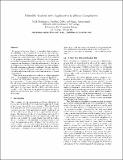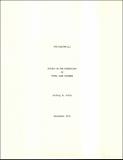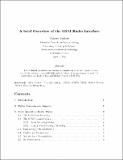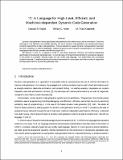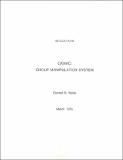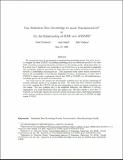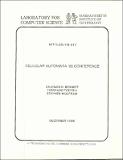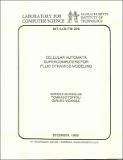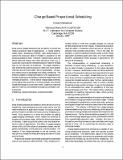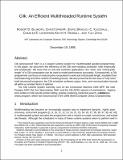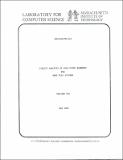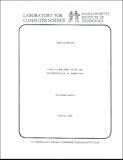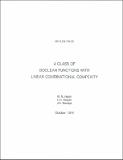Browsing LCS Technical Memos (1974 - 2003) by Title
Now showing items 41-60 of 492
-
Bicontinuous Extensions of Invertible Combinatorial Functions
(1979-01)We discuss and solve the problem of constructing a diffeomorphic componentwise extension for an arbitrary invertible combinatorial function. Interpreted in physical terms, our solution constitutes a proof of the physical ... -
Bitwidth Analysis with Application to Silicon Compilation
(1999-11)In this paper introduces Bitwise, a compiler that minimizes the bitwidth - the number of bits used to represent each operand - for both integers and pointers in a program. By propagating static information both forward and ... -
Bounds on the Scheduling of Types Task Systems
(1978-09)We study the scheduling of different types of tasks on different types of processors. If there are k types of tasks and mi identifical processors for takss of type I, the finishing times of any demand driven or list schedule ... -
BRAND X Manual
(1980-11)BRAND X is a simple representation language implemented as a pure extension of LISP. BRAND X provides the following additional facilities over LISP: Unique and canonical structures, property lists for all objects, labels ... -
A Brief Overview of the GSM Radio Interface
(1996-03)This technical memorandum contains a compilation of several papers, reports and books relative to the GSM-900 radio interface. It is not exhaustive and it is restricted to the Traffic Channel/Full-Rate Speech (TCH/FS). -
The Byzantine Firing Squad Problem
(1985-04)A new problem, the Byzanntine Firing Squad problem, is defined and solved in two versions, Permissive and Strict. Both problems provide for synchronization of initially unsychronized processors in a synchronous network, ... -
'C: A Language for High-Level, Efficient, and Machine-independant Dynamic Code Generation
Dynamic code generation allows specialized code sequences to be crafted using runtime information. Since this information is by definition not available statically, the use of dynamic code generation can achieve performance ... -
CAMAC: Group Manipulation System
(1975-03)CAMAC is a collection of group manipulation progams with an easy to use interface. With groups defined by either generating permutations or generators and relations the system can find coset tables, normalizers, centralizers, ... -
Can Statistical Zero Knowledge be made Non-interactive? or On the Relationship of SZK and NISZK
(1999-09)We extend the study of non-interactive statistical zero-knowledge proofs. Our main focus is to compare the class NISZK of problems possessing such non-interactive proofs to the class SZK of problems possessing interactive ... -
A Case Study of Shared Memory and Message Passing: The Triangle Puzzle
(1995-01)This thesis is the first controlled case study that compares shared-memory and message-passing implementations of an application that solves the triangle puzzle and runs on actual hardware: only the communication interfaces ... -
Cellular Automata '86 Conference
(1986-12) -
Cellular Automata Supercomputers for Fluid Dynamics Modeling
(1985-12)We report recent developments in the modeling of fluid dynamics, and give experimental results (including dynamical exponents) obtained using cellular automata machines. Because of their locality and uniformity, cellular ... -
Characterizing Second Order Logic with First Order Quantifiers
(1978-02)A language Q is defined and given semantics, the formulae of which are quantifier-free first-order matrices prefixed by combinations of finite partially ordered first-order quantifiers. It is shown that Q is equivalent in ... -
Charge-Based Proportional Scheduling
(1996-05)Most priority-based schedulers lack the ability to control the relative execution rates of applications. A recent scheme, called lottery scheduling [WW94], uses randomization to control the execution rates of threads in ... -
Cilk: An Efficient Multithreaded Runtime System
(1996-01)Cilk (pronounced "silk") is a C-based runtime system for multithreaded parallel programming. In this paper, we document the efficiency of the Cilk work-stealing scheduler, both empirically and analytically. We show that ... -
Circuit Analysis of Self-timed Elements for NMOS VLSI Systems
(1982-05)Scalingof VLSI digital systems introduces new problems to the design of synchronous systems, due to the disproportional increase in wire delays with the decrease in transistor sizes. One the other hand, the asynchronous ... -
Circuit-size Lower Bounds and Non-reducibility to Sparse Sets
(1981-10)As remarked in Cook (1980), we do not know any nonlinear lower bound on the circuit-size of a language in P or even in NP. The best known lower bound seems to be due to Paul (1975). In this paper we show that first for ... -
A Class of Boolean Functions with Linear Combinatorial Complexity
(1974-10)In this paper we investigate the combinatorial complexity of Boolean functions satisfying a certain property, P^nk,m. A function of n variable has the P^nk,m property if there are at least m functions obtainable from each ...


